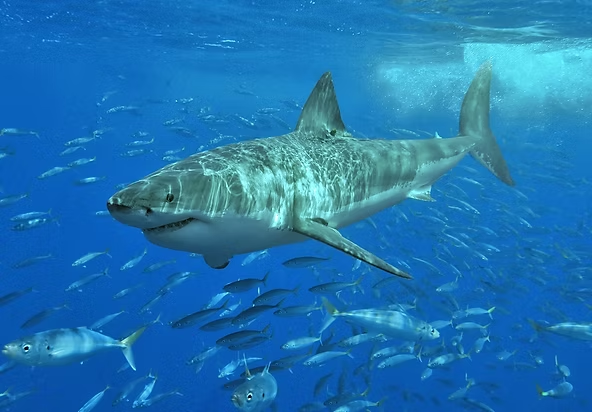Great White Sharks: Apex Predators of the Ocean
The white shark (Carcharodon carcharias), commonly called the great white shark, is among the largest surviving mackerel sharks and one of the most dangerous predators globally.
Distribution
White sharks are commonly detected off the coasts of the northeastern and western United States, northern Japan, Chile, southern Australia, southern Africa, New Zealand, and the Mediterranean, preferring temperate coastal waters. While some migrate into tropical seas or far out to sea, most return annually to temperate feeding grounds.
Body Structure
- Great whites have robust, torpedo-shaped bodies, a powerful crescent-shaped tail, large pectoral and dorsal fins, and a pointed conical head.
- They display a whitish belly and gray, dark blue, or brown coloring on the back and sides.
- Equipped with enormous, serrated teeth designed to slash flesh and pierce bone.
- Adult sharks may reach 6.4 meters (21 feet) and weigh between 680 to 1,800 kg, with some exceeding 2,270 kg (5,000 pounds).
Feeding Habits
- Juvenile white sharks feed on fish and smaller sharks.
- Mature sharks hunt sea turtles, seals, porpoises, sea lions, dolphins, and small whales.
- They often employ ambush tactics, delivering a lethal initial bite that may knock prey from the water.
- Feeding strategies include “bite and spit” or “bite and wait,” letting prey die before returning to feed.
Social Behavior
White sharks are mostly solitary with limited understanding of their social dynamics. Some evidence shows territorial behavior and dominance hierarchies at feeding sites. Occasional pairs may travel together, while individuals may stay in one area or migrate extensively. Tagged sharks off California have been traced to Hawaii, and sharks off South Africa have traveled to southern Australia.
Reproduction
- White sharks reproduce via internal fertilization; males insert claspers into the female’s cloaca.
- Female sharks reach sexual maturity at 4.5–5 meters in length and 12–18 years of age.
- Male sharks mature at 3.5–4 meters and around 10 years old.
- Detailed courtship behaviors remain largely unknown due to the species’ elusive nature.

